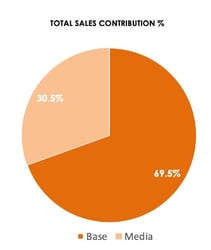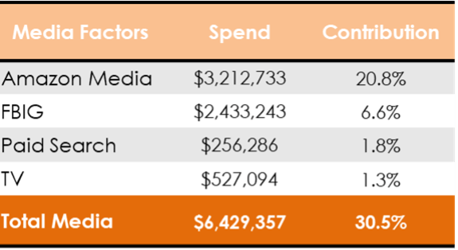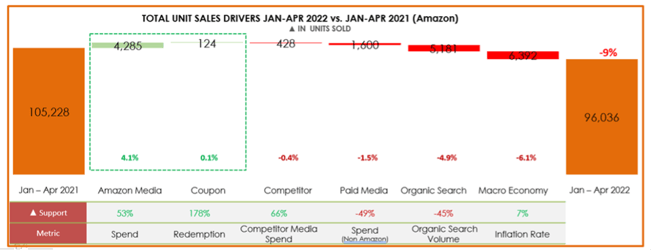Many brands, particularly those that started out with a DTC model, tend to view their media spend in a siloed way. When brands invest media dollars to support their DTC efforts, it’s natural to assume you’ll receive a strong, positive ROAS for brand .com sales. However, today’s omnichannel shoppers expect brands to be present wherever they shop, which means diversifying distribution channels, promoting all available options…and thinking about measurement holistically.
THE FLAWED VIEW OF SILOED MEASUREMENT
Because we can’t dictate where a user eventually purchases, the siloed view of looking at DTC sales isn’t representative of consumer behavior. Just because an ad drives someone to a brand website doesn’t guarantee they’ll buy there. And so, you cannot simply measure DTC spend against DTC sales—a more holistic, full-business view is required.
Advanced analytics models can help us uncover the true impact of DTC spend—which often extends beyond the targeted channel. Even prior to model build, it’s critical to look at media against total sales—even when the sales impact is not isolated to DTC media driving efforts. Our analytics work proves the existence of a DTC-spend halo, offering data-backed proof that the benefits of DTC spend can be seen elsewhere.
START WITH UNDERSTANDING YOUR CONSUMER
Let’s use the beauty category as one example of the omnichannel experience and its impact: 75% of beauty shoppers buy from Amazon.com, while 63% shop on Sephora.com and 60% on Ulta.com[1]. 40% of users purchase from brand websites. Amazon is frequently where ecommerce users convert—and while they certainly convert on brand websites, too, 61%—the majority—turn to brand websites when researching beauty products online. Consumers are not shopping or discovering in silo—and so brands cannot look at their media returns in silo, either.
This thinking applies to offline vs. online purchase behavior, too—ads simply do not dictate where a consumer purchases a product.
From the above research, it is very clear why beauty brands split their efforts across DTC, Amazon, Sephora, and Ulta—and why they support ads driving to those different retailers. Often, the creatives in those ads are not that different—just the landing page is. Targeting parameters can sometimes be misleading or misrepresentative because consumers shop everywhere. Brands end up reaching similar audiences, via many different outlets. Again, every media dollar spent has the potential to influence consumer decisions and sales across all purchase outlets, not just the one it was aimed at.
THE HALO EFFECT IN ACTION: A BEAUTY BRAND CASE STUDY
Using a Marketing Mix Model we quantified the exact contribution that DTC spend had on Amazon sales for a client. This time series regression model used the client’s own historical data to measure the contribution that media and non-media (economic, competitor, etc.) factors had on sales. We adhere to best-in-class practices for stat testing and, therefore, results are measurable and predictable. We discovered that media driving to brand.com had a significant halo on brand sales on Amazon. What’s more:
- Ads driving to the brand website (not Amazon) contributed a surprising 12% to total Amazon sales (channels: TV, Meta, Paid Search).
- Ads specifically targeted toward Amazon drove 20% of the brand’s total Amazon sales.
- Amazon-specific media did not have as large a halo on DTC sales.
- Nearly 70% of the brand's Amazon sales originated from non-paid channels like subscriptions, returning customers, seasonality, and organic traffic.
- Reducing DTC spend not only resulted in lower DTC sales but also a 2% decrease in Amazon sales year-over-year.
In this case, media with the primary job of pushing DTC sales did that job—but also positively contributed to the Amazon business. The reduction of DTC spend negatively contributed to the Amazon business.

|

|

A HOLISTIC APPROACH WINS
Leveraging advanced analytics and modeling techniques allows us to pinpoint the specific impact of each channel on a business, which is incredibly valuable. However, it’s also important for brands to step back and view their media spending in the broader context of the whole business.
Ready to efficiently power the DTC halo effect for your brand? Connect with us to learn more about how our advanced analytics can help you optimize your marketing strategy for omnichannel success.
[1] For the full list of where beauty users shop digitally, see our white paper.



COMMENTS